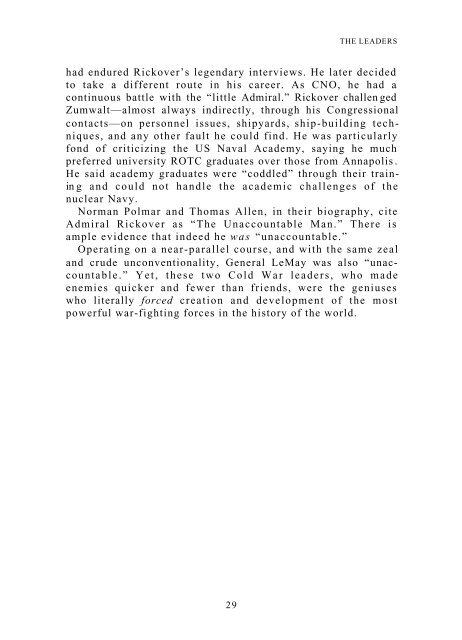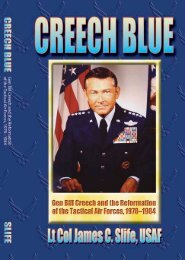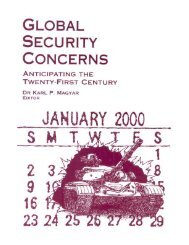Inside the Cold War - Project Gutenberg Consortia Center
Inside the Cold War - Project Gutenberg Consortia Center
Inside the Cold War - Project Gutenberg Consortia Center
You also want an ePaper? Increase the reach of your titles
YUMPU automatically turns print PDFs into web optimized ePapers that Google loves.
THE LEADERS<br />
had endured Rickover’s legendary interviews. He later decided<br />
to take a different route in his career. As CNO, he had a<br />
continuous battle with <strong>the</strong> “little Admiral.” Rickover challen ged<br />
Zumwalt—almost always indirectly, through his Congressional<br />
contacts—on personnel issues, shipyards, ship-building techniques,<br />
and any o<strong>the</strong>r fault he could find. He was particularly<br />
fond of criticizing <strong>the</strong> US Naval Academy, saying he much<br />
preferred university ROTC graduates over those from Annapolis.<br />
He said academy graduates were “coddled” through <strong>the</strong>ir trainin<br />
g and could not handle <strong>the</strong> academic challenges of <strong>the</strong><br />
nuclear Navy.<br />
Norman Polmar and Thomas Allen, in <strong>the</strong>ir biography, cite<br />
Admiral Rickover as “The Unaccountable Man.” There is<br />
ample evidence that indeed he was “unaccountable.”<br />
Operating on a near-parallel course, and with <strong>the</strong> same zeal<br />
and crude unconventionality, General LeMay was also “unaccountable.”<br />
Yet, <strong>the</strong>se two <strong>Cold</strong> <strong>War</strong> leaders, who made<br />
enemies quicker and fewer than friends, were <strong>the</strong> geniuses<br />
who literally forced creation and development of <strong>the</strong> most<br />
powerful war-fighting forces in <strong>the</strong> history of <strong>the</strong> world.<br />
29






